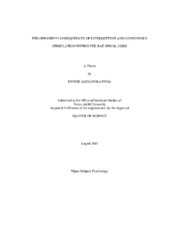| dc.description.abstract | A substantial body of work exists to suggest that brain and spinal mechanisms
react differently to nociceptive information. The current experiments were design to
identify parallels and differences in the way the spinal cord processes nociceptive
information, as compared to intact animals. In addition, pharmacological manipulations
were employed to identify the opioid receptors activated by continuous shock, and to
decipher at what synaptic level (e.g. pre or post synaptically) intermittent shock affects
the release of endogenous opioids. A common dependent variable was used in all
experiments to assess changes in nociceptive reactivity, the tail-flick test.
The results revealed that intermittent and continuous stimulation have an
opponent relationship on nociceptive processing in the isolated spinal cord. Continuous
stimulation (3, 25-s continuous 1.5 mA tail-shocks) induced an antinociceptive response
that was attenuated by prior exposure to brief (80 ms) intermittent shock (Experiment 1).
When intermittent shock was given after continuous shock, intermittent shock failed to
attenuate continuous shock-induced antinociception (Experiment 2). The impact of
intermittent shock on continuous-shock induced antinociception decayed after 24 hours
(Experiment 3). Intermittent and continuous shock enhanced the antinociceptive consequences of a moderate dose of systemic morphine (5 mg/kg) (Experiment 4).
Continuous shock-induced antinociception was attenuated by equal molar concentrations
of CTOP (µ opioid antagonist) and Nor-BNI (κ opioid antagonist), but not naltrindole (δ
opioid antagonist) (Experiment 5). Intermittent shock failed to attenuate the
antinociception induced by DAMGO (µ opioid agonist) or Dynorphin A (κ opioid
agonist). | en |


